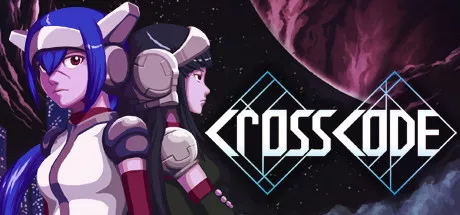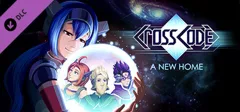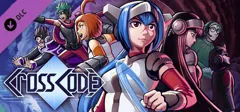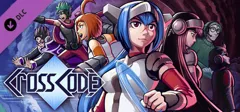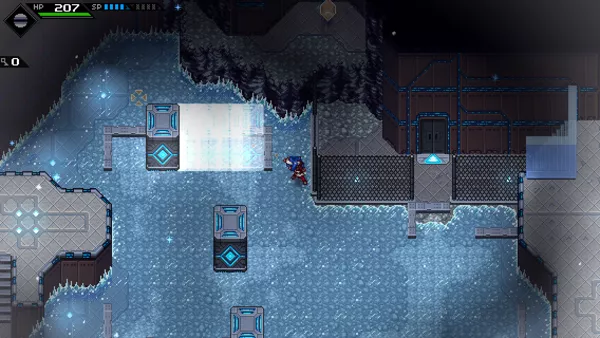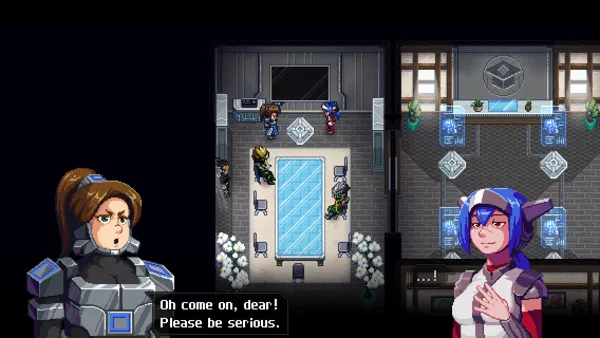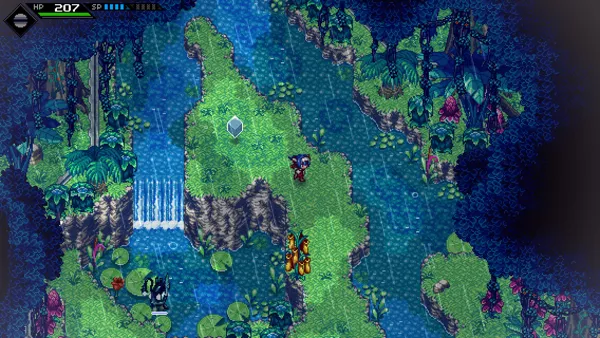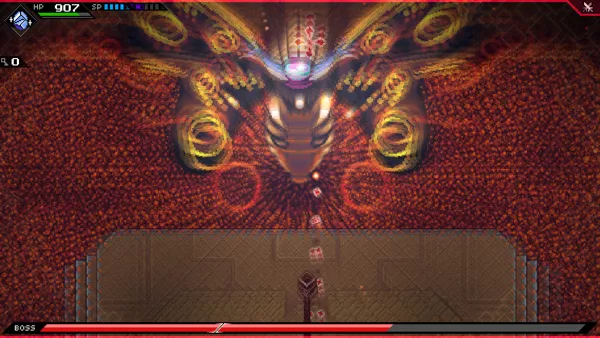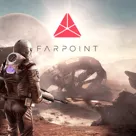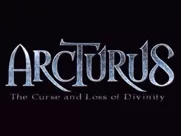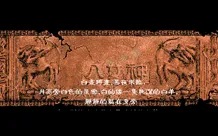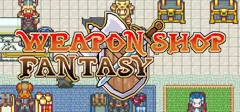CrossCode
Official Description (Ad Blurb)
This retro-inspired 2D Action RPG might outright surprise you. CrossCode combines 16-bit SNES-style graphics with butter-smooth physics, a fast-paced combat system, and engaging puzzle mechanics, served with a gripping sci-fi story.
CrossCode is all about how it plays! That's why there is a free Steam demo! Go give it a try!
Take the best out of two popular genres, find a good balance between them and make a great game. That’s what CrossCode does. And it works pretty well. You get the puzzles of Zelda-esque dungeons and are rewarded with the great variety of equipment you know and love from RPGs. During the fast-paced battles you will use the tools you find on your journey to reveal and exploit the enemies' weaknesses and at the same time will be able to choose equipment and skills for a more in-depth approach in fighting your enemies.
Check the Reviews to see who loves the game. We're sure you will, too!
Source: Steam Store Description
Spellings
- クロスコード - Japanese spelling
- 远星物语 - Simplified Chinese spelling
Groups +
Promos
Videos
See any errors or missing info for this game?
You can submit a correction, contribute trivia, add to a game group, add a related site or alternate title.
Credits (Windows version)
107 People (70 developers, 37 thanks) · View all
| Creative Director |
|
| Main Programmers |
|
| Music Composer |
|
| Sound Designers | |
| Story & Lore |
|
| Concept Art |
|
| Area Level Design |
|
| Dungeon Level Design |
|
| Menu Design |
|
| Menu Programming |
|
| Enemy Design |
|
| [ full credits ] | |
Reviews
Critics
Average score: 88% (based on 21 ratings)
Players
Average score: 3.9 out of 5 (based on 7 ratings with 1 reviews)
Log in to this sprawling top-down epic!
The Good
* Superb world and dungeon design
-
Good story backed by rich, multi-layered lore
-
Excellent combat and RPG elements
-
Great soundtrack
-
Unexpectedly massive in size and content
The Bad
* Pacing issues in the latter portions of the game -
Chests could have been hidden behind more overworld puzzles
-
Minor interface issues when handling consumables
-
Very heavy on timing based puzzles
The Bottom Line
I’ve always had a certain level of frustration with early access games. On the one hand, they can often appear like cynical cash grabs, coming from developers who release a broken product on Steam, take your money, and are never heard from again. Sometimes, the product is so poor that it fails to impress, even once in full release. Yet every once in a while you’ll run across a game that is so exceptional that the wait for a full release is painful. That happened to me with CrossCode, a crowdfunded top-down action-RPG developed by German developer Radical Fish Games.When I encountered the demo for this game back in 2015, I couldn’t help but be dazzled by it. It had slick, smooth graphics, unique combat, challenging puzzles, an intriguing story and a great soundtrack to boot. It was more or less perfect in every way, apart from the major ‘flaw’ of simply not being done yet. It would be another agonizing three year wait before the final release, but I have to say it was completely and utterly worth it. CrossCode is the retro adventure of your dreams, evocative of all of the classics such as The Legend of Zelda, Alundra, and Secret of Mana, yet utterly modern in its design approach.
CrossCode takes place in the far future on a faraway planet. The planet has been terraformed for use in an online game called “CrossWorlds”, which allows users to fully immerse themselves, body and mind, into their avatars using a fancy technology called “Instant Matter”. It’s not virtual reality, its real reality, or at least as close as you can get without actually being in another place. You play as Lea, a girl who has lost her memories and is seemingly only conscious when logged into CrossWorlds. With the help of a hacker and a few CrossWorlds maintenance technicians, her goal is to discover what happened to Lea’s memories, while also immersing herself in CrossWorlds. As a result, much like another one of my favorite RPGs in recent years, Horizon Zero Dawn, there are multiple layers to the story: The story within the CrossWorlds game, the lore behind its creation, and the story of Lea regaining her memories. It’s a very intriguing structure, and all of stories are more than compelling enough to make you want to see the adventure through to the end. The payoff is surprisingly emotional and gave me the same feelings as finishing many classic 16-bit adventures.
The writing is filled with lots of geeky references and fun pop-culture nods. Many of the quests have truly quirky and bizarre storylines, which only add to the fun. While some side characters initially come across as being very ethnically stereotypical, they eventually grow into valuable friends. The universe the game creates is a fascinating one to say the least, and the lore and encyclopedia which develops over the course of the game is extremely, dense with text, far more than you’d ever expect for an indie action-RPG. Anyone who wants to immerse themselves in a new sci-fi gaming universe should definitely take a look at this game.
As Lea, you take on the class known as the Spheromancer, which is considered CrossWorlds’ hardest class to play, being something of a jack-of-all-trades. As a spheromancer, you can fight using both melee attacks and throwing Virtual Reality Projectiles, or balls. Balls can be rapidly fired or aimed to provide a stronger shot that bounces off of walls and objects. This is crucial for solving the game’s many puzzles.
Combat is fast, frantic and very tactical. You have to constantly dodge, guard, shoot, and utilize all of Lea’s abilities if you hope to survive. All enemies and bosses have very specific ways of “breaking” them to so they can be stunned: throwing balls at a weak spot, using other enemies to break shields, and using environmental items, among others. Each enemy is a puzzle to be figured out. In addition, Lea has an “SP” meter which can be used for powerful special attacks. This fills up slowly over time, though you can fill it faster by attacking enemies. Specials are activated when shooting, dodging, attacking, or guarding and holding down the right trigger. The longer you hold it down, the more points you’ll use, and the more powerful the attack is.
Much like in Breath of the Wild, Lea can purchase or craft various foods which grant healing and buffs during combat, including defense and attack. Unlike the recent Zelda game however, using these consumables during combat can be challenging - not only is there a 10 second cooldown after using them, but items take time to consume, which can be a problem when enemies are attacking all around. You’ll have to be smart when timing the use of these items. I do wish there was a way to eat multiple items in one selection, but there isn’t. You can unlock gear which allows Lea to have multiple consumables active, and late game consumables provide multiple buffs at once. Still it doesn’t fully mitigate this otherwise minor inconvenience.
While exploring the overworld, enemies can be engaged in at your leisure. While the game will encourage you to fight enemies for their drops and experience, they rarely pose a threat if you’re simply passing by. Fighting groups of enemies will increase a “rank” meter on the right, this increases both the experience earned as well as the quality of the drops.
The other major mechanic during exploration is platforming. Every area has its own height map, and you’ll need to mentally work out paths and solve various puzzles to reach chests and objectives in the game world. Chests contain rare materials and weapons, so exploration is always rewarded. Sometimes, you’ll have to leave a screen you’re on to approach the area from a higher height. Jumping is automated just as in the old 3D Zelda games, so platforming is less about timing and more about visually understanding the paths to take.
One thing that is a bit disappointing about this is the way chests are handled. The more involved chests will be locked by certain keys, which can only be obtained after finishing the various dungeons. Since you also earn elemental items in the dungeons, it would have been smarter to hide these chests behind puzzles which could only be solved with the correct elements. Some chests are hidden in this manner, but many of them can be reached before you are allowed to open them, which can be very defeating at first. Thankfully, you can mark chests on your map, so you’ll remember to open them when you come back to them. Still, I do think Radical Fish could have been a bit smarter in handling these.
By exploring the game’s major dungeons, you will unlock the four elemental forms: fire, ice, shock, and wave. Okay, not exactly the four elements we know and love, but at least the game is aware of this. Each element has its own skill tree and special attacks, and you gain the bonuses from that tree when you switch to that element. Attacking enemies with a certain element enough times can apply a status element to an enemy. You’ll need to take elements in mind when attacking the enemies and use the elements they are weak to to make for an easier fight. Using elemental attacks too much will result in a balance overload which forces you to use your base form until the balance meter is completely depleted, so you’ll have to switch to your base form on occasion to balance things out.
The four elements also are used for solving the numerous puzzles you’ll come across in dungeons. Much like Zelda dungons, CrossCode’s dungeons are gauntlets of puzzle rooms and combat rooms, with a boss at the end. You acquire the dungeon’s element at the midpoint of each dungeon, then fight a boss at the end. What’s great and sometimes frustrating about the dungeons is that they aren’t afraid to be long, meaty, and challenging. Puzzles demand both great thought, reflexes, and precision. You’ll generally need to push blocks, hit far-off switches with well-aimed balls, and figure out how each element works with the dungeon’s puzzles. Whenever I was stuck on a puzzle, it was always because I had overlooked something obvious about it. Many puzzles are timed and require you to interact with a Rube Goldberg machine of switches and elemental items in a very precise, quick order, so trial-and-error execution gets more common as you reach the later stages of the game. There’s a setting to slow these puzzles down to make them easier on yourself.
You’ll also need to make sure you come in sufficiently equipped and stocked up when taking on the enemies and bosses in each dungeon, as some encounters are no joke. Since each dungeon is instanced, you will not receive help from your AI party members, who are very competent fighters. Bosses are exceptionally well-designed, with unique strategies to take each one down that get progressively more difficult to pull off as the fight goes on.
As you complete quests and level up, you’ll earn circuit points. These points can then be placed in various nodes in five different boards, one for each elemental form plus your base form. Most nodes will raise various stats, while others will grant you various special attacks. The special attack nodes can actually be switched between two different branches, and there are attacks which use one, three, and eventually six SP points. By this point in the game it won’t be possible to get every node on the board, so you’ll need to focus on the kinds of attacks you do end up using, as well as the stats and bonuses you want. Thankfully, it is possible to use circuit overrides in the starting town to re-spec the circuit boards to match the direction you wish to go with your build.
CrossCode utilizes the Impact engine, a game engine written in HTML5. Its amazing that such a high-quality game can be made with such an unconventional technology, though its not 100 percent perfect. There was some minor stuttering in the more crowded town areas, though for the most part the game runs fine apart from the most intense end-game combat scenarios. Otherwise, CrossCode’s aesthetic is beautiful, combining pixel-art nostalgia with modern-day techniques to create a look that while similar to many indie games, is also somehow a cut above them. The sprites and environments are lush and colorful. Scrolling and camera zooming are smooth, and the environments are teeming with particle, lighting, and shadow effects. Combat is extremely flashy and fills the screen with damage numbers and explosions, especially during high-end specials. Character portraits are highly detailed and amazingly expressive, which really helps during the dialog sequences where Lea cannot speak. Certain scenes also cut to “cinematic” shots, which make for really cool moments. Its an example of what some have termed the “hi-bit” art design, reminiscent of games such as Owlboy.
CrossCode’s soundscape is deliberately retro. All of the tunes have a very “classic” video game sound to them. The sounds during combat are punchy and clear, and the menu sound effects are very pleasing to the ear. There is no voice acting, which is keeping with the style of games. Still, some speaking wouldn’t have gone amiss in such a lore-heavy game as this. I also wasn’t a huge fan of the drum-roll sound effect which happens every time an enemy is killed. It just makes things seem more dramatic than they really are most of the time, though it is cool to hear the effect slowed down whenever a boss is defeated. Apart from that, and the cries of some enemies, the sound in crossCode is mostly solid.
One thing that is truly amazing about CrossCode is its length. In terms of content and length, CrossCode can rival and surpass even some of the most popular AAA games on the market. My Steam counter says I put in 70 hours in CrossCode, which is utterly insane, though weirdly my save file says I have 60. Either way you slice it, that is a tremendous value for your money. CrossWorlds is a huge world with plenty of quests and secrets, and you’re likely to spend just as much time navigating it, gathering crafting materials, and exploring for chests as you are in dungeons and solving quests. In an era where so many developers happily ship half-finished, short games for full price, Radical Fish should be commended for being so uncompromising in giving players a complete, lengthy, and well-rounded experience, especially coming out of early access. And there’s still more to come, with content such as an arena mode and a DLC epilogue promised for the future.
At the same time though, the game can suffer from some serious pacing issues. The game’s main story moves along at a good clip, balancing quests, exploration, and dungeoneering until the halfway point, when you are suddenly whisked away during a quest to a new area you previously had no knowledge of. The chapter after that features three dungeons you have to complete plus a new town and the largest area in the game to explore. It’s a lot to ask for all at once, and I wish the game had doled out this content in a way where it didn’t feel so exasperating to get through. Yes, even in gaming, there is such a thing as too much of a good thing. Still, I walked away from CrossCode more than satisfied not just with its quantity, but its overall quality.
CrossCode might be just have the perfect alchemical formula for everything I like in a game, or at least everything I like in an action-RPG. It delivers challenging combat while not skimping on brain-busting puzzles. It delivers a compelling story without compromising on gameplay. It’s also graphically pleasing with a catchy, beautifully composed soundtrack. No element of the game feels undercooked or unbalanced. Everything is done well here, and my only faults are simply nitpicks when I compare this game to others in its genre. This is an example of a game that needs to be way more popular than it is, and it’s honestly better than quite a few AAA releases from the last few years. If this is how good indie games can get, who needs the latest overhyped mass-market disaster?
Windows · by krisko6 (814) · 2019
Analytics
Upgrade to MobyPro to view research rankings!
Identifiers +
Contribute
Are you familiar with this game? Help document and preserve this entry in video game history! If your contribution is approved, you will earn points and be credited as a contributor.
Contributors to this Entry
Game added by mars_rulez.
Windows Apps, Nintendo Switch, PlayStation 4, Xbox One added by Rik Hideto. PlayStation 5 added by Kam1Kaz3NL77. Luna added by Sciere.
Additional contributors: Rik Hideto.
Game added March 3, 2017. Last modified March 17, 2024.
